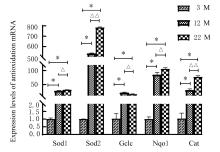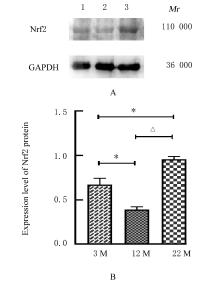| 1 |
CRUZ-JENTOFT A J, BAHAT G, BAUER J, et al. Sarcopenia: revised European consensus on definition and diagnosis[J]. Age Ageing, 2019, 48(1): 16-31.
|
| 2 |
MUSCI R V, HAMILTON K L, LINDEN M A. Exercise-induced mitohormesis for the maintenance of skeletal muscle and healthspan extension [J]. Sports (Basel), 2019, 7(7): 170.
|
| 3 |
REYNOLDS J C, LAI R W, WOODHEAD J S T,et al.MOTS-c is an exercise-induced mitochondrial-encoded regulator of age-dependent physical decline and muscle homeostasis [J]. Nat Commun, 2021, 12(1): 470.
|
| 4 |
BORI Z, ZHAO Z F, KOLTAI E, et al. The effects of aging, physical training, and a single bout of exercise on mitochondrial protein expression in human skeletal muscle[J]. Exp Gerontol, 2012, 47(6): 417-424.
|
| 5 |
NGUYEN T, SHERRATT P J, NIOI P, et al. Nrf2 controls constitutive and inducible expression of ARE-driven genes through a dynamic pathway involving nucleocytoplasmic shuttling by Keap1[J]. J Biol Chem, 2005, 280(37): 32485-32492.
|
| 6 |
ITOH K, YE P, MATSUMIYA T, et al. Emerging functional cross-talk between the Keap1-Nrf2 system and mitochondria[J].J Clin Biochem Nutr,2015,56(2): 91-97.
|
| 7 |
BOSE C, ALVES I, SINGH P, et al. Sulforaphane prevents age-associated cardiac and muscular dysfunction through Nrf2 signaling[J]. Aging Cell, 2020,19(11): e13261.
|
| 8 |
HUANG D D, YAN X L, FAN S D, et al. Nrf2 deficiency promotes the increasing trend of autophagy during aging in skeletal muscle: a potential mechanism for the development of sarcopenia[J].Aging,2020,12(7): 5977-5991.
|
| 9 |
BUCH B T, HALLING J F, RINGHOLM S, et al. Colchicine treatment impairs skeletal muscle mitochondrial function and insulin sensitivity in an age-specific manner[J]. FASEB J, 2020, 34(6):8653-8670.
|
| 10 |
BARBIERI E, AGOSTINI D, POLIDORI E, et al. The pleiotropic effect of physical exercise on mitochondrial dynamics in aging skeletal muscle[J]. Oxid Med Cell Longev, 2015, 2015: 917085.
|
| 11 |
PETERSON C M, JOHANNSEN D L, RAVUSSIN E.Skeletal muscle mitochondria and aging: a review [J]. J Aging Res, 2012, 2012: 194821.
|
| 12 |
FERREIRA R, VITORINO R, ALVES R M P, et al. Subsarcolemmal and intermyofibrillar mitochondria proteome differences disclose functional specializations in skeletal muscle [J]. Proteomics,2010,10(17): 3142-3154.
|
| 13 |
BARBIERI E, SESTILI P. Reactive oxygen species in skeletal muscle signaling [J]. J Signal Transduct, 2012, 2012:982794.
|
| 14 |
LI C Q, ZHAO Y Q, ZHOU S, et al. A comparison of the antioxidant effects between hydrogen gas inhalation and vitamin C supplementation in response to a 60-min treadmill exercise in rat gastrocnemius muscle[J]. Front Physiol, 2021, 12: 745194.
|
| 15 |
GUO X X, JIANG Q, TUCCITTO A, et al. The AMPK-PGC-1α signaling axis regulates the astrocyte glutathione system to protect against oxidative and metabolic injury[J]. Neurobiol Dis, 2018, 113: 59-69.
|
| 16 |
ST-PIERRE J, DRORI S, ULDRY M, et al. Suppression of reactive oxygen species and neurodegeneration by the PGC-1 transcriptional coactivators[J]. Cell, 2006, 127(2): 397-408.
|
| 17 |
CANNAVINO J, BROCCA L, SANDRI M, et al. PGC1-α over-expression prevents metabolic alterations and soleus muscle atrophy in hindlimb unloaded mice[J]. J Physiol, 2014, 592(20): 4575-4589.
|
| 18 |
AQUILANO K, BALDELLI S, PAGLIEI B, et al. p53 orchestrates the PGC-1α-mediated antioxidant response upon mild redox and metabolic imbalance [J]. Antioxid Redox Signal, 2013, 18(4): 386-399.
|
| 19 |
TONELLI C, CHIO I I C, TUVESON D A. Transcriptional regulation by Nrf2 [J]. Antioxid Redox Signal, 2018, 29(17): 1727-1745.
|
| 20 |
SUN C C, YANG C L, XUE R L, et al. Sulforaphane alleviates muscular dystrophy in mdx mice by activation of Nrf2[J]. J Appl Physiol (1985),2015,118(2): 224-237.
|
| 21 |
CARTER H N, CHEN C C W, HOOD D A. Mitochondria, muscle health, and exercise with advancing age[J].Physiology (Bethesda),2015,30(3): 208-223.
|
| 22 |
HOLLOWAY G P, HOLWERDA A M, MIOTTO P M,et al.Age-associated impairments in mitochondrial ADP sensitivity contribute to redox stress in senescent human skeletal muscle[J]. Cell Rep,2018, 22(11): 2837-2848.
|
| 23 |
BAIRD L, DINKOVA-KOSTOVA A T. The cytoprotective role of the Keap1-Nrf2 pathway[J]. Arch Toxicol, 2011, 85(4): 241-272.
|
| 24 |
HUR W, GRAY N S. Small molecule modulators of antioxidant response pathway[J]. Curr Opin Chem Biol, 2011, 15(1): 162-173.
|
| 25 |
JOHNSON M L, ROBINSON M M, NAIR K S. Skeletal muscle aging and the mitochondrion[J]. Trends Endocrinol Metab, 2013, 24(5): 247-256.
|
| 26 |
MARZETTI E, CALVANI R, CESARI M, et al. Mitochondrial dysfunction and sarcopenia of aging: from signaling pathways to clinical trials[J]. Int J Biochem Cell Biol, 2013, 45(10): 2288-2301.
|
| 27 |
RISTOW M, ZARSE K. How increased oxidative stress promotes longevity and metabolic health: the concept of mitochondrial hormesis (mitohormesis)[J]. Exp Gerontol, 2010, 45(6): 410-418.
|
| 28 |
HE F, LI J, LIU Z, et al. Redox mechanism of reactive oxygen species in exercise[J].Front Physiol,2016,7: 486.
|
| 29 |
HARMAN D. Aging: a theory based on free radical and radiation chemistry[J].J Gerontol,1956,11(3):298-300.
|
 )
)
 )
)






